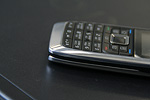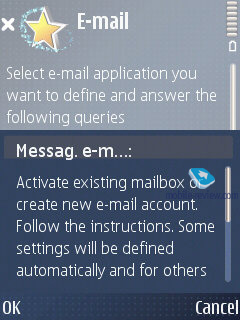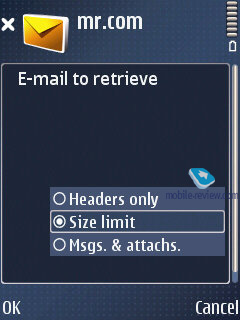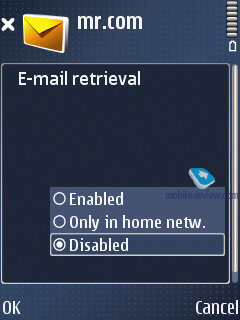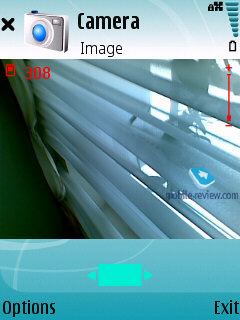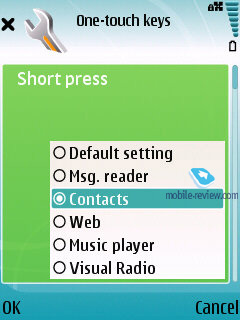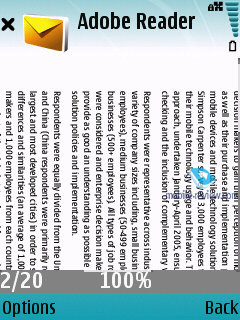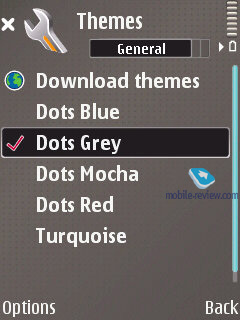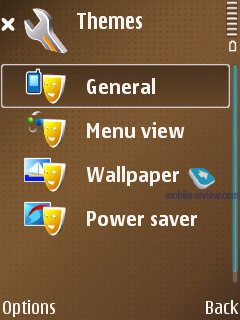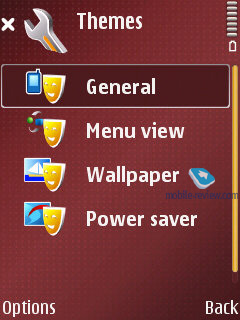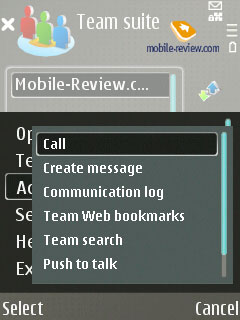|
|
Review of GSM/UMTS-smartphone Nokia E51
Live photos of Nokia E51
Table of contents:
- Positioning
- Nokia E51 – unique traits
- Design, size, controls
- Display
- Keypad
- Battery
- Bluetooth, USB, WiFi, IrDa
- Memory, memory cards
- Performance
- Camera
- Applications, themes
- Nokia E51 versus Nokia 6120, Nokia E50
- Impressions
Sales package:
- Handset
- Battery (BP-6MT)
- Charger (AC-5)
- USB data cable (DKE-2)
- Wired stereo-headset (HS-47)
- Software CD
- User Guide
- Velvet cleaning cloth
Positioning
In our preface to this review we ponder over why the Eseries devices have never been really popular on the market. If, for some reasons, you have missed this write-up, I strongly recommend that you read it, so as to get a better idea of the way the Nokia E51 is positioned, as described here. Since Nokia was constantly blowing hot and cold, its E65 came out positioned towards the mass market, rather than the corporate segment. They even didn’t have enough time to arm it with the functionality they had originally devised or the instant single-press application start up feature. Take a closer look at the keypad of the Nokia E65 and the Nokia E51 – they look really resembling, however having no proper software back up, the former’s extra keys turned out way too bog-standard.

The Nokia E51 had to arrive a tad later (3-4 months max) after the Nokia E65. However it wasn’t meant to happen, since the slider–type handset got rushed out first. That’s how the product range's philosophy got cracked and the gap was left unfilled, which is all another proof that the Eseries develops spontaneously, patching up one hole in the line-up after another. Early release of the Nokia E65 and a very moderate demand for the model retailing for 400 Euro on its launch day – all this incited Nokia Enterprise Solutions to knock down the phone’s price so as to support its sales. Over almost three quarters the Nokia E65’s price tag lost 15 percent in weight, which is the most they could take off it (unless it is a product with no sales at all or a major crises, when Nokia adjusted all prices by 7-11 percents).
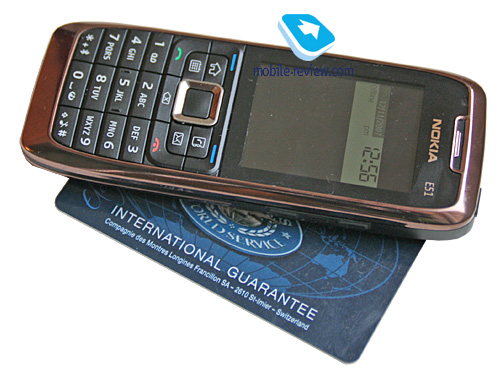
Other Eseries-branded offerings weren’t popular back then either. For instance, the Nokia E60 was such a “hot” product, that they removed all records of it from the official page, except for the customer support section. As a matter of fact, the only two devices that have made it past the one-million mark were the Nokia E65 and the Nokia E50, which is a very modest performance as far as Nokia is concerned, to say the least.
If you are still in doubt, then try to explain it to me, how come the Nokia E51 and the Nokia E65, packing similar feature sets, go for pretty much the same money. As it stands now, the Nokia E65 goes for around 320 Euro in most European regions, and 320-350 Euro in Russia. At the same time, the same 340-350 Euro will buy you a Nokia E51. You sure there will be a bunch of people crazed about this phone when its elder sibling is around? Coming in a more fancy shell and a different form-factor? Who will actually delve deep into their spec sheets only to find out that the E51 runs on a different hardware platform? Very few. Either of the handsets offers identical consumer value – camera, WiFi, preinstalled applications and business-minded functionality.
The Nokia E65’s rushed release had also sabotaged the company’s plans in another way – the market got the Nokia 6120 Classic, which came in cheaper and earlier than the Nokia E51. Which means that the average consumer looking for a reasonably priced Symbian-powered smartphone is going to focus on this offering, for the 70-Euro difference is too much. Other bits and pieces like the least possible margin this handset is sold at, and almost no more room left for dropping the price, won’t concern them.
So the relatively expensive Nokia E51 has only one way to go as far as its positioning is concerned – aggressive advertising campaign that can make the device recognizable and sought-after. However Enterprise Solutions’s ad budgets are no match for Nokia Mobile Phones, and what is more, they are pretty much scattered across its portfolio. Which brings us to a predictable finale – the E51 will get its massive advertising campaign only in April, which is not without a bit of good sense, as that will be the time when the Nokia E65 should get withdrawn from the market. Even in spite of the fact it is the Eseries’s frontline offering today.
Now look at the big picture again to see how all Nokia’s premature actions spoiled the game for Enterprise Solutions. But in the preface we dropped some words on the Nokia E51’s being a unique solution, so what’s so special about it?


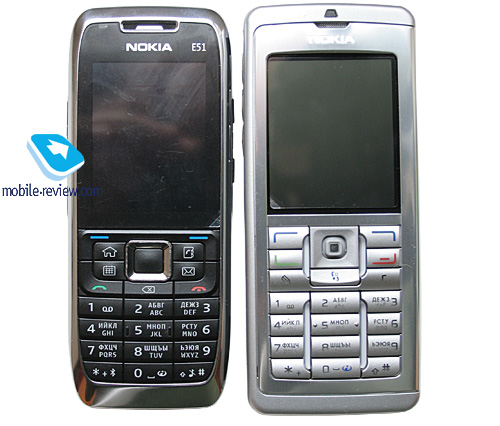



The Nokia E50 was a svelte, pocket-friendly smartphone, which was its eye-grabbing spec. The Nokia 6120 Classic exercises the same approach, plus it is the most affordable Symbian-based product in the line-up to day. What’s so unique about the Nokia E51, when it seems there are no records left to be set?
Let me say a seditious thing, which you probably will be making fun of me for. Well probably. But what appears to make no sense at all, on a closer examination turns into something more meaningful.
The Nokia E51 runs Symbian OS, and in this sense it is a smartphone, while in fact it is a feature phone - that’s the way it was designed. All its smartphone perks are just pleasant and optional bonuses. This is the only way to look at the Nokia E51 – as a feature phone.
So, that’s about it. It bothers you a little, when someone claims that a feature-packed smartphone is in fact a feature phone, right? Perhaps this would have been my first reaction as well, had I not played with the Nokia E51 for quite a while.
Over all these years, phone makers have been so into the “arms race”, trying to beat all competitors with extra features and tricks, that nobody has ever though of every handset’s primary department – calls. Don’t get me wrong, there have been some voice enhancement technologies, new codecs, and the users could actually hear all these improvements and appreciate the fine tuning. But as far as in-call ergonomics is concerned, they have never attempted to alter it. Get a 5-7 year old enterprise device and some today’s solution – they work in the same fashion. Side-mounted volume controls, numeric keypad, a dedicated voice recorder button on one of the spines and that’s pretty much about it.
Since Enterprise Solution didn’t have a multitude of ways to go or compete within Nokia – the realm of multimedia was barred due to the NSeries; imaging was a no-no as well, for it was banned from the ESeries right in the very beginning. So they had only one way-out – create a phone centered on its main application, calls. And the Nokia E51 in this respect is one sublime phone.
Back to the table of contents >>>
Nokia E51 – unique traits
What puts many off in smartphones? Tangled device management system, labyrinths of menus, and a bevy of useless features. That’s what all surveys on this matter suggest, and the reaction of the phone makers is to get their products closer to feature phones in terms of look and feel characteristics. Look at Sony Ericsson with its W960i, where they sacrificed a number of its fortes so as to lend it the feel of a feature phone. The Nokia E51 exercises exactly the same approach, yet with a positive outcome.
The first thing you run into – the keypad now features a button marked with a house icon, which will feel so familiar from Windows Mobile powered devices. The reason why it has been carried over is not WM-based devices dominating the market (out of the blue), so everyone needs to comply with them. By no means. The real reason is the ergonomics of Microsoft’s software solutions – the software giant has been through the mill with them, and can roll out very intuitive and straightforward applications. For desktop systems, at least – its Windows Mobile is quite far from intuitive to be honest.
And the Home button is one of the better ideas – very easy to catch its purpose and master. It will also make its way to other Nokia-branded smartphones in due course, as the current menu icon can well befuddle inexperienced users.
Another change to the E51’s physical appearance is the “C” button that has gone missing – in return we now have a key picturing a left arrow and a cross. While the “C” stood for “correction”, its new version is similar to a desktop’s keyboard and implies that you can also cancel your actions with it. If I remember it right, this button made its first appearance in communicators, represented today by the Nokia E90.

The amount of effort they have put into the revamp of such a “trivial” part of the handset as its key captions, is truly tremendous. The average user with no real experience of handling S60-powered devices will feel right at home with the E51 all thanks to its intuitive controls.
One of the E51’s trademark features are 4 separate buttons (including the Menu key) which by default stand for quick launch of the Calendar, Phonebook and Email. Moreover, it actually makes some difference whether you click them or tap and hold. With a short press you jump into the general list of the phonebook, mail box or the month view of the Calendar. Long presses, however, will create a new entry: a contact, an event or an email. Press any of these buttons again to return back to the main menu. And since they are all marked accordingly, you will have absolutely no trouble getting around your phone this way.
Those who would like to reprogram these buttons to some different functions will be happy to know that the Settings have some options for these purposes, allowing you to bind own applications to these keys. /p>
So while at the standby screen, you don’t need to delve into the menu, which proves to be so complex on most S60 handsets, that you will get lost in no time – the E51 offers a better way to move about your phone, more importantly, it is speedier than Active Standby, since a hardware key acting as a shortcut is always a better way to go. It especially comes in handy when having a call via a headset, for you can get into any section of the phone literally in one touch, without having to dig deep into the menu, trying to find some particular function. In case you are wondering whether the E51 allows for the standard menu navigation, just like on all other S60 devices – it does.
But that’s not all goodies the E51 has in stock for your calls – sitting on the right-hand spine are the volume controls, separated by a bit of free space, occupied by the Mute button. Obviously, pressing it disables the handset’s microphone. And while this feature is nothing really new, you couldn’t take advantage of it just by clicking a dedicated button on most other solutions before. Even on the Nokia E65 where you can also mute the mic, this button is housed on the front plate, meaning that you will need to look at the phone to find it.

Mounted on the left-hand flank is the Voice key, which activates voice commands while at the standby screen, including speaker-independent voice dialing. And when having a phone conversation, you can start up the voice recorder by hitting this button Again, the E51 scores for flawless usability of this feature.

Just like we would expect from a ESeries device, there is a LED indicator informing you about all missed calls, messages or new letters (can be set up from the menu). This is one of the best things about the E51 – while this indicator won’t bother you with some of its sound notifications, you will always know you have some missed events.


And this is probably the point where we are winding it up – the above should be just enough to give you a clue that the Nokia E51 is one of the best devices around, as far as calls and basic functionality (messages, organizer, phonebook) are concerned, all thanks to its application shortcuts and call-related features on tap with hardware buttons. The E51 will definitely appeal to regular users who have no idea of what the smartphone is – they won’t spend more than a dozen of minutes punching different buttons so as to figure out what is what and come to grips with the phone.
And those who actually have some skills in handling smartphones, will appreciate the E51 even more. The Active Standby screen holds a number of modules for setting up your voice mail, email and VoIP. So after running through the Setup wizards for these functions, you will get a bunch of ready-to-go applications, whereas the wizards will disappear from the main screen.
While the concept is pretty clear, the way it is implemented could use some tweaking, since not all settings will appear clear to the average user from the word go. Nevertheless, this is obviously a huge leap forward, since many don’t even suspect their phones have some of the above smarts onboard.
Wrapping it all up, we are quite confident that the Nokia E51 is a unique product, whose calling features are as strong as we have never seen before, while its smartphone face is definitely there, but it is not what this phone is all about. Nokia has just come up with a decent device for performing all basic operations – this is where the E51 does its best.
Proving our point that the E51, as a smartphone, won’t be the best way to go for power users, is its pretty miniscule display, which may give you a lot of trouble if you need to handle tons of emails. This display is designed rather for quick read-throughs, but the vast majority of users will have nothing against this particular usage scenario.
Thanks to a number of coincidences, the Nokia E51 is the first device where the marriage of an easier-to-use interface and untouched functionality is the first thing you run into. This process of fine tuning is become a top-priority for Nokia – they will also tweak other models, but it will take some time.
Now that we are through the moot point of the E51 being more of a feature phone than a smartphone, we are moving on to our review routine.
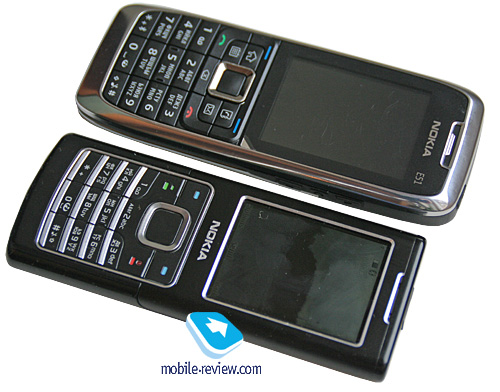
Back to the table of contents >>>
Design, size, controls
The handset comes in a choice of three colors – black, silver and bronze, which also differ with the rear plate’s pattern. For instance, you get dots with the silver trim, circles with the bronze and stripes with the black color scheme.

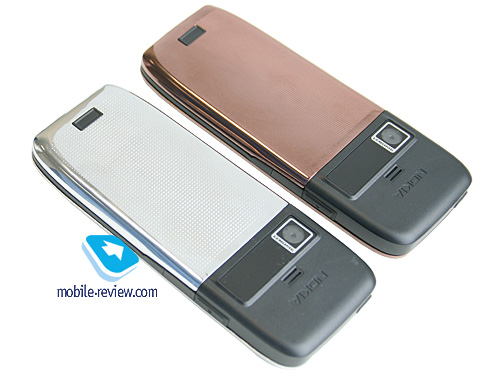







The build quality was never an issue with the E51 – no parts felt floppy whatsoever. What is more, it was amazingly palm-friendly. There is also a batch of metal accents – specifically, the battery compartment cover and the display’s frame. Despite all this stainless steel in it, the E51 tips our scales at just 100 grams, which definitely won’t weigh you down in general. At the same time it delivers a very pleasant feel of something weighty when held in the hand. Measuring up at 114x46x12 mm, it stands in one line with the most petite offerings in this class.




The E51 houses the service indicator for incoming messages, missed calls, etc. You can customize it and on top of that, this LED is extremely bright, so you won’t overlook it for sure.


The left-hand spine hosts the voice key, made of rubber and delivering a nice tactile feel. Flipping over to the right side, you will find two volume controls, the Microphone Off key (actives voice dialing as well). The power button sits on the upper edge of the handset.

Mounted on the bottom end of the phone, are the charger socket (2 mm), the audio jack (2,5 mm), and the miniUSB slot. Competing the exterior of the E51 is the loudspeaker’s slot on the rear alongside the 2 Mpix camera lens.

Back to the table of contents >>>
Display
The E51’s display sports 2-inch diagonal and the resolution of 240x320 pixels (31x41 mm), showing up to 16 million colors. All this results in a bright and vibrant picture. This model is actually notable for its pretty much decent display, standing in one line with today’s offerings.


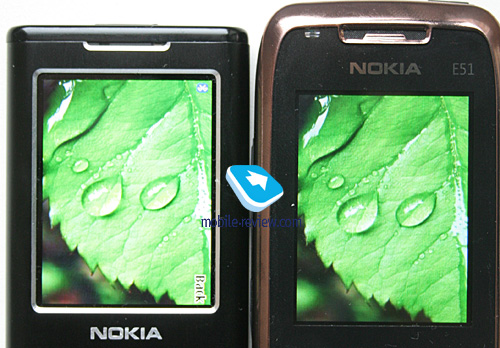


The display remains readable in the sun (TFT), which is mainly due to the tinted protective layer. However, even this screen starts glaring heavy on some occasions, so you will need to find the right angle. Regrettably, given the display’s relatively tiny diagonal, it is not very convenient to use outdoors, which is also true of other phones with 2-inch screens onboard.
The display’s brightness is adjusted automatically by the bundled ambient light sensor.
The display accommodates up to 9 text and 3 services lines. The font size won’t give you any trouble, furthermore, you can manually adjust its size for some modes and applications.
Back to the table of contents >>>
Keypad
The E51’s no-frills keypad looks and feels very conventional. All buttons are reasonably stiff and travel quite deep into the casing. All in all it is a joy to handle – keypad-wise, the E51 is definitely above many contemporary offerings.



The keys are lit in white, furthermore, the keypad’s backlighting is turned on and off by the inbuilt ambient light sensor.

We won’t go through the phonebook key and other dedicated buttons here – learn more about them in the “Unique traits” part of the review.
Back to the table of contents >>>
Battery
I have been running into statements that this handset comes packed with one of the most powerful cells around – naturally, this translates into longer battery time in consumers’ minds. Formally, it is the way the things stand with the E51 – the phone does house a 1050 mAh, Li-Pol battery, which is good for 4.23 hours of talk time and up to 13 days of standby, according to the maker.

In Moscow the handset stayed up and running for around 2 days (one hour of calls, a couple of SMS, 2,5 hours of music, a few WiFi connections for mail checks). Those who won’t be heavy on the E51’s extra functionality will squeeze 2 days out of it, and in case of the calls-only usage mode, it may well be good for like 2-3 days (depends on how much you talk).
However, the E51 turns out to be a more power hungry device than those powered by S40. Shorter standby time is the most notable difference – depending on the S40 model you take, the actual number may vary, but should get at least one day of standby more with the S40 (given comparable battery capacity). Nevertheless, for a phone of its type, the Nokia E51 is a decent performer on this front. Regrettably, there is no higher-capacity cell available for the handset.
It takes the E51 around 1 hour and 45 minutes to charge from empty to full.
Back to the table of contents >>>
Bluetooth, USB, WiFi, IrDa
USB. The handset comes equipped with the miniUSB socket, rather than the microUSB, found on some of the company’s latest and greatest offerings. The handset comes in with USB 2.0 support (data transfer speeds – 800 Kb/s), upon a successful PC connection you can choose one of the following modes (the NSeries also supports MTP and Image Print):
- Data Transfer (Mass Storage USB) – memory cards is available, no drivers required, as your OS identifies the handset automatically.
- PC Suite – used for device management via Nokia PC Suite, enables all features of the phone, data backup etc.
Bluetooth. The E51 sports EDR-enabled Bluetooth 2.0 alongside the following profiles:/p>
- A2DP
- AVCRP
- BIP-ImagePush
- DUN-GW
- FT-Server
- HandsFree-AG (1.0)
- Headset-AG
- OBEX
- OPP-Client
- OPP-Server
- SIM Access-Server
The top speed you can get with the E51’s Bluetooth connection is around 100 Kb/s. We also tested its A2DP profile in pair with the Sony Ericsson DS970 headset, which worked just fine – we managed our play list, skipped within tracks and adjusted volume seamlessly, however we couldn’t make current track’s title show up on the E51’s display.
Wi-Fi. This handset comes armed with Wi-Fi (IEEE 802.11 g) support. All security standards are supported: WEP , WPA , WPA 2, with other advanced settings available. Unlike the NSeries, the E51 doesn’t support Universal PnP (UPnP). Although, it boasts the WiFi Wizard, which can search and tap into available networks in the background mode.
The IrDA’s data transfer speed tops out at 115 Kb/s.
Back to the table of contents >>>
Memory, memory cards
The handset ships with around 128-130 Mb of storage that can be managed by the user. The RAM size is 96 Mb, after the E51’s first start up the user can access around 50 Mb of this volume. The microSD memory expansion slot is housed under the battery compartment cover, and allows you to swap cards on the fly. The maximum memory card size supported by the device is unlimited – we plugged in our 4 Gb unit and experienced absolutely no problems with it.

Back to the table of contents >>>
Performance
Thanks to its updated hardware platform and increased RAM volume the E51 is a better performer compared to the previous models. In all other aspects, it is comparable with Nokia’s current models.



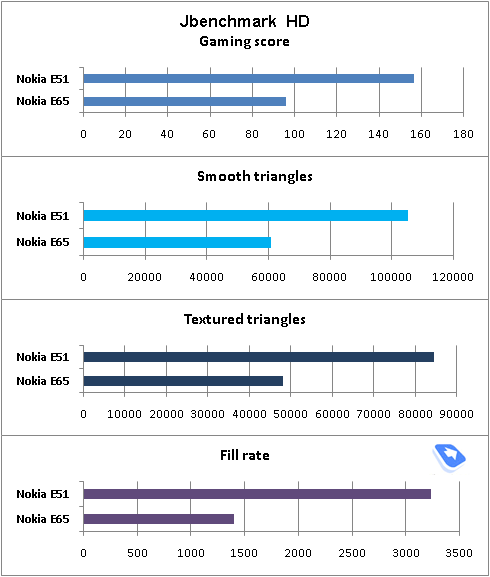
Back to the table of contents >>>
Camera
The E51 comes armed with a 2 Mpix unit with no auto-focus, which can take pretty average snaps quality-wise. While your shots will look just fine on the phone’s display, taking them to a PC won’t be the best idea. There are three quality levels available (High, Normal, Basic), and two resolutions – 1600x1200 pixels and 640x480 pixels.

Speaking of its extra features, these are: multishot mode, self-timer (10, 20, 30 seconds), overlays (Sepia, Black&White, Negative), night mode and white balance (auto, Sunny, Incandescent, Fluorescent).
 |
 |
| (+) maximize, 1600x1200, JPEG |
(+) maximize, 1600x1200, JPEG |
 |
 |
| (+) maximize, 1600x1200, JPEG |
(+) maximize, 1600x1200, JPEG |
 |
 |
| (+) maximize, 1600x1200, JPEG |
(+) maximize, 1600x1200, JPEG |
 |
 |
| (+) maximize, 1600x1200, JPEG |
(+) maximize, 1600x1200, JPEG |
 |
 |
| (+) maximize, 1600x1200, JPEG |
(+) maximize, 1600x1200, JPEG |
 |
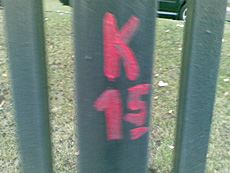 |
| (+) maximize, 1600x1200, JPEG |
(+) maximize, 1600x1200, JPEG |
 |
 |
| (+) maximize, 1600x1200, JPEG |
(+) maximize, 1600x1200, JPEG |
 |
 |
| (+) maximize, 1600x1200, JPEG |
(+) maximize, 1600x1200, JPEG |
Video. The E51 can capture video in one of the following resolutions: 320x240 pixels, 176x144 pixels, 128x96 pixels. With top quality settings on, its video clips are quite acceptable.
Back to the table of contents >>>
Applications, themes
The user interface featured in the E51 is no different from other products running S60 3rd edition Feature Pack 1. You can learn about this system’s standard suite of functions in our dedicated write-up.
And here we will focus on the E51’s new abilities and features, which essentially reveal its positioning. The Office section houses a local Search function dealing with all categories within the phone, but it is a dated version of this application and I suppose you will want to have the latest one onboard, like the one coming preinstalled with the Nokia N81 (available on Nokia’s official page, don’t look for it in the E51’s section, though).
QuickOffice comes in its shrunk edition. Specifically, with the version found in the Nokia E51 you won’t be able to edit office documents. To go beyond the Read Only mode you will need to pay extra money. The company doesn’t see the E51 as a potent device for editing documents, which is quite obvious given its display diagonal – hence its shrunk QuickOffice version.
ZIP – enables you to extract files from archives or create new archives.

Adobe PDF – allows reading PDF-files, no complaints about the application.
Surprisingly, the E51 comes preinstalled with both Note and Active Notes, even though these two do pretty much similar things and don’t come together on most other devices.
The no-frills Themes found in the E51 look pretty neat.
The handset’s Music department doesn’t seem to be its real strength – it is a typical S60 player with the equalizer onboard, as well as the 2,5mm audio jack, which will require an adapter if you want to you’re a pair of custom headphones. While the E51 does just okay on the music front, it is far behind other contemporary solutions in all fields – usability, functionality and sonic experience. Although, the ESeries has never been particularly heavy on music.
Team Suite. This is the main app which is unique for this model only, for the time being. In this application you will find a list of commands that is managed and complemented with contacts from the phonebook by you. For each command you are at liberty to create group messages as well as make conference-calls with a flick of button, and communicate with your colleagues via Push to Talk. As for additional capabilities, viewing of communication log and catalogue of new links for a specific command are available. This very application is an add-on over the standard functions, in other handsets such functionality is achieved by spending more time only. Here it is implemented in a more easy-to-use fashion, especially for those who are really in dire need of such functionality.
Back to the table of contents >>>
Nokia E51 versus Nokia 6120, Nokia E50
One of the things we are thrilled to do is compare the E51 with the Nokia 6120, since they are direct competitors on the market, as well as the previous generation of the ESeries:
| |
Nokia E51 |
Nokia 6120 |
Nokia E50 |
| Size, weight (mm, grams) |
114x46x12, 100 |
106x46x15, 89 |
113x43.5x15.5, 104 |
| Metal accents |
Yes |
No |
Yes |
| Display |
2 inches, TFT, 240x320 pixels, 16 mln colors |
2 inches, TFT, 240x320 pixels, 16 mln colors |
2 inches, TFT, 240x320 pixels, 262K colors |
| Battery |
BP-6MT, 1050 mAh |
BL-5B, 890 mAh |
BL-5C, 970 mAh |
| Battery life (rated, standby and talk time) |
Up to 13 days, 4.23 hours |
Up to 9 days, 3.1 hours |
Up to 9 days, 6.28 hours |
| Battery life (tested) |
2 days 9 hours |
2 days |
2 days 7 hours |
| Music time (highest volume settings, default headphones) |
12 hours 40 minutes |
10 hours 11 minutes |
11 hours 20 minutes |
| Bundled memory |
130 Mb |
35 Mb |
70 Mb |
| RAM (type, available to the user) |
SDRAM, 96 Mb, 50 Mb |
SDRAM, 64 Mb, 20 Mb |
SDRAM, 32 Mb, 16 Mb |
| Memory card |
microSD, any size |
microSD, any size |
microSD, up to 2Gb |
| S60 version |
3rd Edition FP1 |
3rd Edition FP1 |
3rd Edition |
| CPU |
ARM11, 369 Mhz, Freescale |
ARM11, 369 Mhz, Freescale |
ARM9, 235 Mhz, single-chip solution |
| |
|
|
|
| Camera |
2 Mpix |
2 Mpix |
1.3 Mpix (camera-less edition available) |
| FM-radio |
Yes |
Yes |
No |
| IrDA |
Yes |
No |
Yes |
| WiFi |
Yes |
No |
No |
| Programmable keys |
Yes, up to 4 |
No |
Yes, third-party application required |
| SAR (W/kg) |
1.4 |
1.18 |
0.86 |
| Original price |
350 Euro |
260-270 Euro |
280-300 Euro |
The first thing you come across are the Nokia E51’s metal accents, however this also leads to the highest SAR level among these three. On the other hand, I don’t think this very parameter is worth being too concerned about – while adverse effects of calls via cellular phones are pretty much obvious, they haven’t been proven as yet, but the they are easily overcome with a wired or wireless headset, which I highly recommend in case you spend more than an hour on the phone daily.
The Nokia E51 and the Nokia 6120 turns out to be pretty much resembling hardware- and software-wise, however the Nokia E51 ships with more RAM onboard, as well as the IrDA port (this connectivity option caters for the needs of the target audience ), WiFi, plus programmable keys.
The difference of 70-80 Euro between them is what you pay for WiFi, metal accents and a pack of other small changes. But is it justified? Yes, but for a very limited number of people, who do know what WiFi is and what it is meant for. Basically, it would be way too naive to expect the WiFi connectivity to be the E51’s foremost selling point, since most companies doesn’t have any sort of infrastructure for this to work properly. So the only place to go for the E51 is the mass market with its subtle advantage of having metal accents in its design (which usually translates into a better build quality in the eyes of consumers).
Back to the table of contents >>>
Impressions
In terms of its reception quality, the E51 is a very typical Nokia-branded offering – no real merits or flaws, which comes as no surprise, however, given how similar it is to the Nokia 6120 hardware-wise. The ring tones were pretty loud with the E51; we didn’t experience any difficulties with hearing it in various environments. The vibro alert is average strength-wise.
Is the E51 rivaled by solutions from other manufacturers? As I see it, there are none, and the reason for that is pretty simple – it is a pricey model for those who are bent only on calls and can’t see their phones housed in a form-factor other than candy-bar. Had any other manufacturer attempted to roll out such a handset, it would have been dead even before its release day, but Nokia finds itself in a different position, all thanks to its brand strength.
However, there is no way the E51 will appeal to the masses – this handset is rather aimed at those who do know what it is capable of and what it is designed for. As a feature phone, this is one unique device, delivering a truly gratifying experience. As a smartphone, however, it is fiddly and actually is of no real use. So the right way to treat this phone is this: a feature phone with a pinch of smartphone’s functionality onboard. This is also indicated by the stingy suite of preinstalled applications – obviously, not the thing we expect from these devices. The E51 isn’t a multimedia-ready solution either, being a year or a tad more behind the market.
Turns out that Nokia has come up with a decent device for calls, rather than a do-it-all solution, whose steep price will put many off, and probably, the momentum will have been long gone when it gets lower. The price curve of the Nokia E50 clearly shows that the maker is not going to retail products for less than production costs, which is quite understandable. Don’t think the Nokia E51’s price will drop down to the watermark of the Nokia 6120 Classic any time soon – its expected life time is around 15-18 months and at the bottom point of the price curve it will go for about 280-290 Euro. In order for the strategy of aggressive price cuts to succeed the E51 should either become an ultra-bestseller (which it won’t be, because of the Nokia 6120 and the Nokia E65) or have no sales at (very unlikely). It will see reasonable sales and grab in a sizable share on the market of handsets design for calls alone, which are not synonymous with entry-level phones (like many look at them). For example, the Nokia 8800 is another handset for calls.
Nokia should be presenting this handset as a feature phone with some smartphone perks, rather than an enterprise solution with loads of extras onboard, which don't make any impression on consumers. This handset is a great business-minded offering for calls, actually, one of the best as of today. It can be easily recommended for your second device, especially when you aren’t too concerned about price tags. And in case a smartphone/communicator-grade functionality is not one of the essentials for you, camera is not a top-priority either and you normally listen to favorites tunes with a stand-alone music player, then the E51 can well fit in the role of your primary device.
The trend set by the Nokia E51 will go through other Nokia’s models as well, for the most part in the Eseries, since these phones get easier to master this way. The E51’s so-hyped WiFi connectivity is in fact required only by a small part of its target audience. This is also indicated by the presence of the IrDA port, which is the thing a lot of the phone’s prospective owners don’t view as an anachronism. If you put IrDA on one scale and WiFi on the other, two technologies from different times, you will see that together they shape up a very controversial portrait of the E51’s owner – he is conservative and tech-savvy at the same time. But in the real world, these two extremes never come together in one man.
One of our last reasons why this model will never take the market by storm is that Nokia hasn’t involved its corporate distribution channels for the ESeries, and sells them just like any other mobile phones – through retail networks. This isn’t a particularly great approach, especially, when Nokia’s own line-up comprises a number of rivals for its enterprise solutions.
The Nokia E51 is already available on the European market, whereas its release in Russia is slotted for early January, and no shortage of supplies is expected. If some distributor will actually manage to start shipping it in December, he won’t have many phones on offer, and what is more, the price tags will be much heftier than 350 Euro.
The SAR value for the E51 is 1.4 W/kg. The last thing we would like to do in this write-up is dispel a myth about this phone’s high SAR – it is not caused by the E51’s increased transmitter power, or cutting-edge technologies for better reception quality. The real reason is the handset’s different platform and new location of the antenna (it doesn’t contribute to this SAR level as much as the platform does), which is now housed in its top part right opposite to your ear, whereas many of the today’s phones have it positioned more towards the lower end.
Related links:
Back to the table of contents >>>
Eldar Murtazin (eldar@mobile-review.com)
Translated by Oleg Kononosov (oleg.kononosov@mobile-review.com)
Published — 06 December 2007
Have something to add?! Write us... eldar@mobile-review.com
|
News:
[ 31-07 16:21 ]Sir Jony Ive: Apple Isn't In It For The Money
[ 31-07 13:34 ]Video: Nokia Designer Interviews
[ 31-07 13:10 ]RIM To Layoff 3,000 More Employees
[ 30-07 20:59 ]Video: iPhone 5 Housing Shown Off
[ 30-07 19:12 ]Android Fortunes Decline In U.S.
[ 25-07 16:18 ]Why Apple Is Suing Samsung?
[ 25-07 15:53 ]A Few Choice Quotes About Apple ... By Samsung
[ 23-07 20:25 ]Russian iOS Hacker Calls It A Day
[ 23-07 17:40 ]Video: It's Still Not Out, But Galaxy Note 10.1 Gets An Ad
[ 19-07 19:10 ]Another Loss For Nokia: $1 Billion Down In Q2
[ 19-07 17:22 ]British Judge Orders Apple To Run Ads Saying Samsung Did Not Copy Them
[ 19-07 16:57 ]iPhone 5 To Feature Nano-SIM Cards
[ 18-07 14:20 ]What The iPad Could Have Looked Like ...
[ 18-07 13:25 ]App Store Hack Is Still Going Strong Despite Apple's Best Efforts
[ 13-07 12:34 ]Infographic: The (Hypothetical) Sale Of RIM
[ 13-07 11:10 ]Video: iPhone Hacker Makes In-App Purchases Free
[ 12-07 19:50 ]iPhone 5 Images Leak Again
[ 12-07 17:51 ]Android Takes 50%+ Of U.S. And Europe
[ 11-07 16:02 ]Apple Involved In 60% Of Patent Suits
[ 11-07 13:14 ]Video: Kindle Fire Gets A Jelly Bean
Subscribe
|






